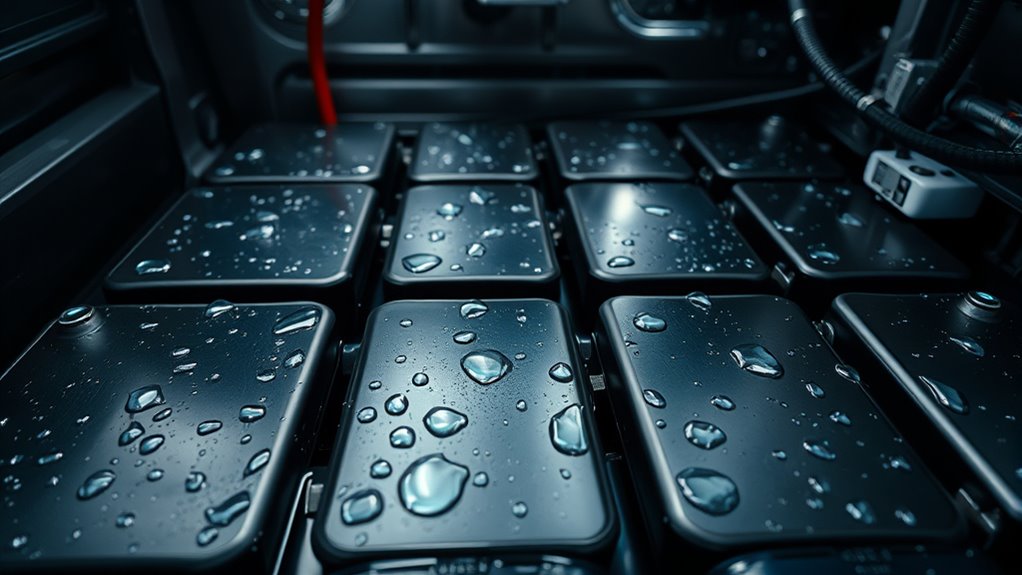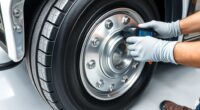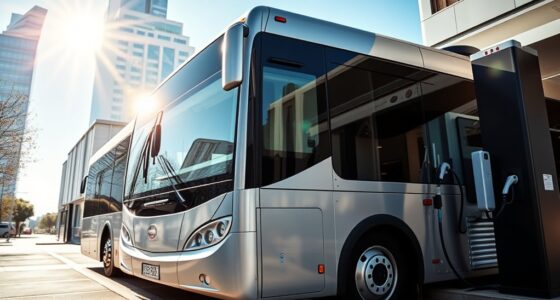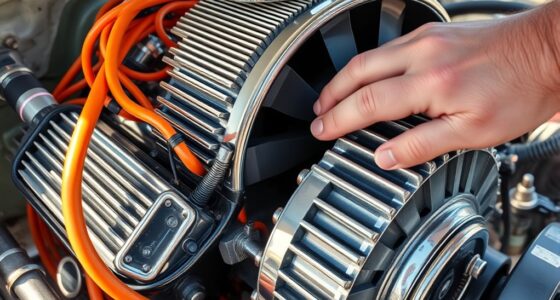If you notice water ingress in your electric bus batteries, immediately isolate the vehicle to prevent hazards. Check for damaged seals, poor insulation, or leaks caused by environmental factors like humidity or flooding. Use protective gear if you need to inspect or dry components, and consider installing moisture-resistant seals or humidity sensors to prevent future issues. Proper maintenance, prompt repairs, and safety protocols can help manage water-related risks—continue exploring to learn more about effective strategies and solutions.
Key Takeaways
- Inspect and replace damaged seals, gaskets, and waterproof connectors to prevent water ingress.
- Install humidity sensors and regularly monitor for signs of moisture inside battery enclosures.
- Conduct routine maintenance, including drainage checks and cleaning to prevent water accumulation.
- Use corrosion-resistant coatings and waterproof components to protect against environmental exposure.
- In case of water intrusion, isolate the vehicle immediately, assess damage, and follow safety protocols before repair.

Water ingress in electric bus batteries poses a considerable safety and performance risk that operators must understand. When moisture enters the battery system, it can cause internal damage that compromises safety and reduces efficiency. Often, this infiltration occurs through damaged seals or environmental exposure, especially in high-humidity areas or during flooding events. Flooding can lead to electrolyte leakage, which quickly damages internal components and causes hazardous chemical exposure.
Defective charging port covers are another common entry point; missing rubber caps or poorly sealed connectors allow water to seep into high-voltage systems, increasing the likelihood of faults or failures. Additionally, poorly insulated battery enclosures are vulnerable; if insulation isn’t adequate, humidity and condensation can build up inside, accelerating corrosion and degradation over time. Environments with high moisture levels, such as coastal regions, further exacerbate these issues by speeding up corrosion processes and water-related failures.
Once water enters the battery system, immediate risks become evident. Moisture-induced corrosion can trigger internal short circuits, leading to thermal runaway—a dangerous condition where the battery overheats uncontrollably. Electrolyte leaks not only threaten the vehicle’s operation but also pose environmental hazards and chemical exposure risks for maintenance personnel.
The vehicle’s safety protocols are designed to detect electrical faults, which often result in HV battery shutdowns, temporarily disabling the bus and preventing further damage. Water damage also reduces battery efficiency by harming the anode and cathode materials, which diminishes capacity and range. In some cases, residual moisture can cause delayed ignition or fires even after initial exposure, making it critical to address water ingress promptly.
Handling water ingress incidents requires strict safety protocols. You should isolate the vehicle immediately to prevent fire spread, especially if flames or smoke are present. Avoid moving the bus if a fire is active, as this can feed the flames with additional oxygen. Responders must wear protective gear to shield against smoke and chemical leaks.
Applying water cooling to contain thermal runaway can be effective, but it should be done cautiously, considering ongoing chemical reactions. After extinguishing, continuous monitoring for reignition is essential, as latent damage may cause fires hours or days later.
To mitigate water ingress over time, you need to upgrade and maintain your battery systems diligently. Installing moisture-resistant seals on charging ports and enclosures prevents water entry. Humidity sensors can alert you to early signs of water ingress, allowing preemptive action. Routine drainage checks of battery trays and enclosures help ensure water doesn’t collect or stagnate. Waterproof connectors for HV wiring and charging interfaces are crucial upgrades, along with anti-corrosion coatings on terminals and busbars.
Regular inspections of rubber seals and cleaning drainage channels during maintenance help prevent water accumulation. Testing insulation resistance after suspected exposure ensures the system’s integrity, and replacing desiccants helps control internal humidity levels, especially in climates lacking climate-control systems.
Environmental factors like high humidity, saltwater exposure, and temperature fluctuations considerably influence water ingress risks. Coastal operations and frequent fast charging can weaken seals over time, increasing vulnerability. Road spray and inadequate underbody protection direct water toward sensitive battery locations, accelerating corrosion.
Post-ingression repairs should focus on replacing damaged cells and components to prevent cascading failures. Addressing water ingress proactively and maintaining rigorous inspection routines ensures safety, longevity, and crucial performance of your electric bus batteries.
Frequently Asked Questions
How Does Water Ingress Affect Battery Lifespan?
Water ingress shortens your battery’s lifespan by causing cell short circuits, electrode corrosion, and dendrite formation, which all reduce capacity and efficiency.
It also damages the battery management system, leading to mismonitoring and increased risk of thermal runaway.
Over time, this accelerates capacity loss, decreases cycle life, and drops the overall health below usable levels.
Regular inspections, proper sealing, and early detection can help you prevent long-term damage.
Are Specific Battery Types More Resistant to Water Damage?
You might wonder if certain battery types resist water damage better. Generally, lithium iron phosphate (LFP) and ternary batteries can offer improved water resistance, especially when housed in waterproof enclosures and sealed packs.
However, most lithium-ion chemistries lack inherent water resistance and rely heavily on design features like sealed casings and protective materials.
Ensuring proper enclosure, materials, and maintenance will help your battery withstand water exposure more effectively.
What Are Early Signs of Water Ingress in Batteries?
Ever wondered how to catch water ingress early? You should look for visible signs like corrosion or moisture around terminals and casing.
Swelling or bulging of the battery indicates internal reactions, while unusual odors suggest chemical leaks.
Keep an eye out for reduced performance or inconsistent power, as these can also signal water has entered.
Addressing these signs promptly helps prevent further damage and guarantees safe operation.
Can Water Ingress Cause Safety Hazards Like Fires?
Water ingress can definitely cause safety hazards like fires. When water enters the battery, it creates conductive pathways that can lead to shorts, arcing, and overheating.
Saltwater, in particular, accelerates corrosion and increases conductivity risks. These issues can trigger thermal runaway, which causes cells to overheat and potentially ignite.
Even if the battery seems dry later, residual damage and corrosion may still cause fires hours or days afterward.
What Are the Best Maintenance Practices to Prevent Water Entry?
You should perform regular visual inspections to spot early signs of water entry and check for any damage. Conduct tightness tests to verify enclosures remain sealed and keep detailed logs of all inspections and repairs.
Install moisture sensors to detect water presence promptly. Use water-resistant materials during design, apply waterproofing compounds, and ensure sealing technologies are up to standard.
Train staff to recognize issues quickly and respond effectively to prevent water from compromising your battery safety.
Conclusion
To keep your electric bus batteries safe from water ingress, always guarantee proper sealing and regular inspections—think of it as your modern-day equivalent of a knight’s armor. Don’t wait for a ‘Dewey Decimal’ disaster to strike; proactive maintenance saves you from costly repairs and downtime. Remember, even in the age of AI, a simple check can prevent a flood of trouble. Stay vigilant, and your batteries will serve you faithfully through many a rainstorm.









